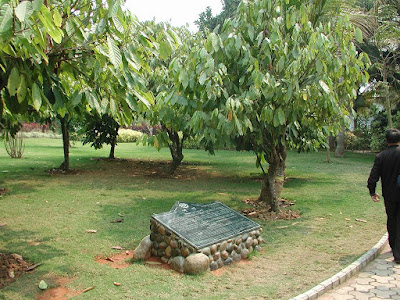Xocolatl! Presumed goat droppings make good god food
Sydney's newest botanical attraction, The Calyx, opened on Saturday, starring Theobroma cacao and its popular products. Lindt is a beneficiary of the products (and a sponsor) giving you a hint about what's inside these yellowish fruits.
(If you want to experience the construction of The Calyx in time-lapse, or see it the way a drone does, talk a look at these videos.)
Theobroma is Latin for 'food of the gods' and those gods were or are presumably those of the Aztecs. Native to tropical America, the Cocoa Tree was called Xocolatl by the Aztecs, meaning bitter water. From Xocolatl we get the species name cacao and our own common names for the crushed beans, Cocoa and Chocolate.
Surprisingly, perhaps, Theobroma is in the mallow family, Malvaceae, with things like hibiscus and cotton. Still, you also find tucked into this family odd things like kapok and durian. There are 21 other species of Theobroma, including one with fruits that are juiced in South America. But chocolate is the main reason you are familiar with the genus.
Chocolate can be good for you, as the possum in the nest above will attest. It's said that eating a little a day - 46-105 grams - can help lower blood pressure. The cocoa seeds have also been used to treat various ailments, including heart disease, in humans.
Mostly we eat the dried and fermented seeds of the Cocoa Tree (which we then call cocoa beans) because they taste good. I like mine with just a little sugar: 70% cocoa, in the 'bittersweet' range in the US, is my preference.
About 30 to 40 of these seeds are produced inside a large yellow, to red or orange, fruit (see top of post) that looks like the Beatles' Yellow Submarine or perhaps a pointy egg. Technically it's a berry but generally referred to as a pod.
Before it fruit, the plant flowers. The flowers erupt out of the stem, something you find in a few tropical plants and which we like to call cauliflory.
According to Royal Botanic Gardens Kew, fruits in the wild are pollinated by midges. In our glasshouses - and the pictures above were taken from the Palm House at Kew Gardens as well as the The Calyx in Sydney - hand pollination is needed. Although ants do help out at Kew Gardens, and there is some kind of blurry midge/fly in the bottom right of the first picture!
Dale Dixon, Curator Manager of Royal Botanic Garden Sydney, says they are struggling to get any viable fruit in the Calyx plants. The small success below, on one of their trees, seems to have aborted before full development.
Even in nature it seems a very small percentage (5% says Kew) of the flowers produce fruit, so there must be constraints on pollination to do with timing the various bits and pieces maturing, or some kind of incompatibility, all to encourage fewer but more 'productive' crossings. The fruits are big so the Cocoa Tree has a strategy of doing what it does well rather than lots of it.
The fresh seeds are covered in a white pulp which discolours to brown when the seeds are dried and fermented (by sun if you have it). You can read elsewhere about the history of chocolate in Europe, and the excitement of discovering that sugar makes it taste better, but let's just say after a slow start when Christopher Columbus disregarded what looked like goat droppings on a canoe, it took off.
 Images: Outdoor trees from Xishuangbanna Tropical Flower and Plant Garden in China, cluster of flowers from Palm House at Kew Gardens, Easter egg nest and squirrel at Kew Gardens, and the rest from The Calyx and nearby (thanks to Dale Dixon and Jimmy Turner for a pre-opening tour). Thanks too to the Royal Botanic Gardens Kew webpage on Theobroma, which is where all the interesting information comes from. To hear more about The Calyx itself, listen to my interview with Dale Dixon for ABC RN's Blueprint for Living. And this is Dale examining the flower of Theobroma cacao...
Images: Outdoor trees from Xishuangbanna Tropical Flower and Plant Garden in China, cluster of flowers from Palm House at Kew Gardens, Easter egg nest and squirrel at Kew Gardens, and the rest from The Calyx and nearby (thanks to Dale Dixon and Jimmy Turner for a pre-opening tour). Thanks too to the Royal Botanic Gardens Kew webpage on Theobroma, which is where all the interesting information comes from. To hear more about The Calyx itself, listen to my interview with Dale Dixon for ABC RN's Blueprint for Living. And this is Dale examining the flower of Theobroma cacao...







Comments